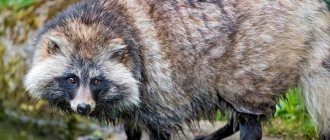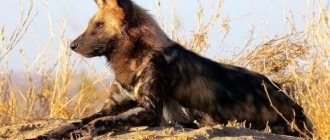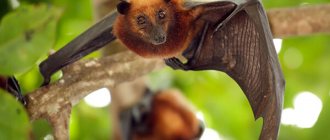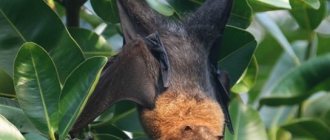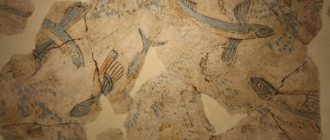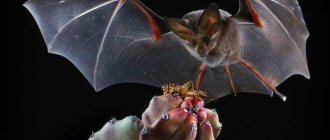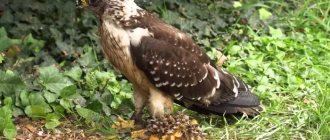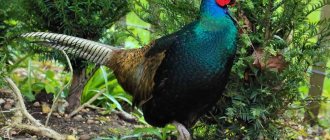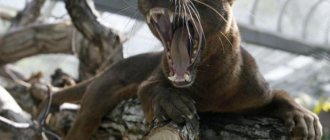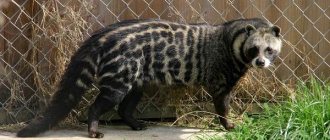Among the diversity of the earth's fauna there is an interesting family of mammals called fruit bats. It belongs to the order Chiroptera, which has more than 170 species. These animals are so interesting that in the process of studying them, a whole science arose - chiropterology.
Large species of fruit bats are especially fascinating, among them:
- flying dogs (Rousettus);
- flying foxes (Pteropus)
Description and features
Among the animal kingdom, a detachment called bats stands out. Its representatives are unique in that they are the only ones from the class of mammals capable of flying, and very well and actively, having wings. This order is diverse and is considered the second most numerous of the mentioned class after rodents. Its members are characterized by some striking features.
The first of them: flapping flight. But it differs significantly from the similar method of movement of birds. This manner of moving through the air allows bats to demonstrate impressive maneuverability and aerodynamics, as well as develop speeds that are truly considerable for terrestrial flying creatures.
Another interesting property is their unique ability to sense the surrounding space and objects located in it. It's called echolocation. These creatures are so interesting that a whole science arose to study them - chiropterology.
This order also belongs to the fruit bat family. Members of one of its genera (Pteropus) are often called flying foxes. Representatives of the other (rosethus) are called: night fruit bats , flying dogs - this is the second name for these creatures.
Both genera, not without reason, are considered by scientists to be the most archaic among their relatives in the order. They differ from other bats in their somewhat primitive skeletal structure. Also, fruit bats cannot boast of a developed ability for echolocation. But this will be discussed in more detail later.
The structure of the wings of such creatures is completely different from that of birds. Like all mammals, they have four limbs, but these are noticeably modified and serve as the backbone for the wings. The latter are a thin elastic membrane of skin, black, brown or yellow-orange in color with dark veins, stretched like a tarpaulin between all the paws and tail, but at the same time freely folding at moments of need.
While moving through the air, these creatures flap their wings very actively, and the membrane of skin stretches significantly, and its area increases almost four times. Such a structure provides advantages for takeoff from a variety of positions, and also increases the speed and convenience of air travel. Fruit bats move in the night airspace without making noise, and have the ability to cover up to 100 km without respite.
The name of the original representative of the fauna: flying dog is undoubtedly due to the noticeable external similarity with the creature mentioned in the name, which is closely familiar to humans. These flying creatures have an elongated muzzle with a nose very reminiscent of a dog's; close-set, large, round eyes; small ears; a body covered with red, brown, yellowish, even greenish or black hair, with noticeable lightening in the lower region of the body.
Their tail is usually short and may be completely absent. The index fingers on the front paws are equipped with claws. The body sizes of such creatures can be very different: from small (about 6 cm) to almost half a meter. The wingspan of the largest fruit bats can be just under two meters.
Such exotic creatures live on the Asian and African continents, as well as in Australia, and inhabit mainly tropical areas, but are often found in the subtropics. Their range includes, in particular, Iran, Japan, Syria, Maldives, and Oceania. All the features of their structure are visible in the photo of a flying dog .
Kinds
It has already been mentioned that fruit bats cannot boast of impressive echolocation abilities, unlike bats. If they are endowed with them, then in an extremely primitive form. The type of orientation in space by reproducing a certain frequency of (ultrasonic) waves is inherent only in certain varieties.
In order to have an idea of surrounding objects when flying in the dark, representatives of some species emit vocal signals that can be called more than original. For example, rosetuses reproduce noises very similar to the ticking of a clock. Sound waves are reflected from objects and animate objects in space and are perceived by the creatures they were sent to. As a result, a picture of the surrounding reality appears in their brain.
But the noises produced by flying dogs are, as a rule, not considered ultrasonic. But the varieties of fruit bats, which do not have enviable abilities for echolocation, have perfectly developed sense of smell, vision and other of the five sense organs inherent to earthly creatures. They help their orientation and life.
Egyptian flying dog
The entire family of fruit bats includes about 170 species. Then they are united into genera, of which there are about four dozen. Among them, the species of flying dogs (Rosetus) are also represented in the most extensive manner. Let's consider the most interesting of the varieties of these creatures.
1. Egyptian flying dog . Representatives of this species have a body length of about 15 cm. They have a short tail, no more than a centimeter. Their body weight is only about 130 g. In the center of their muzzle there are large round eyes that can see perfectly. The wool is very soft and feels like silk. Such creatures are found in Turkey, the Middle East and, of course, Egypt and nearby areas of North Africa.
The story of the Cypriot population is sad. Some time ago it was almost completely exterminated by local farmers. Now in Cyprus, as is known, there is only a small colony of these creatures, the size of which is estimated at only a couple of dozen individuals. This type of flying creature cannot reproduce ultrasonic signals, but for orientation it makes noises, or rather, simply clicks its tongue.
2. Cave fruit bat. Reproduces ultrasonic signals in their simplest form, helping him navigate. The mass of such creatures is usually no more than 100 g. This species is found in China, Pakistan, India, Nepal and some other countries with a similar climate.
Since these creatures inhabit damp, dark caves, they have some features that help them adapt to such a life. Their eyes glow brightly at dusk and emit phosphoric light. They rest, like bats, in an upside down position, attached with tenacious claws to the roof of the cave. If a person finds himself in this place, he can calmly pick up such an animal. They have no fear of people.
Cave fruit bat
3. Kalong - a large flying dog . The body size of representatives of this species reaches 40 cm and can be larger. Such creatures are found in Japan, Iran, Syria and Egypt. Their proximity causes trouble for people, since they can cause considerable damage to fruit plantations. But the Kalongs also suffered from humans because of the taste of their meat, which is considered quite suitable for food.
Flying dog kalong
4. Dwarf fruit bat. The name of this creature is not misleading. This is indeed a very small representative of its genus. Moreover, he is the smallest among his brothers. And its size is comparable to a large insect. Such creatures live in South Asia.
Pygmy fruit bat
Lifestyle of fruit bats
After a hearty meal at dawn, flying foxes return to their roosts, where they will spend the entire day resting their strength after an active night. Winged dogs sleep in flocks in caves or on tree branches. They climb thick branches and hang upside down on their paws and rest in this position. On cool days while sleeping, when flying foxes hang on branches, they wrap their wings around themselves like a blanket, and in hot weather they use them as a fan.
Flying dogs can live in clans on the same tree for tens of years until they are disturbed. These animals prefer a large company of their own kind; settlements of flying foxes often number up to 1 thousand individuals. If necessary, if the area runs out of fruit, fruit bats will fly tens of kilometers, but return to their tree (ceiba, durian and other species). Sometimes during the day you can hear the cries of flying foxes - these are adult males dominating over young ones for the right to have a more comfortable place to rest.
When dusk falls again, the packs of flying dogs will once again set out for their nightly meal. This daily ritual keeps both the fruit bats and their jungle habitat alive. Flying dogs pose a threat only to farmers, because with their numerous colonies they can destroy entire plantations of cultivated crops, thereby causing colossal damage to them.
Lifestyle and habitat
Many species of night fruit bats are easily tamed by humans. These primarily include Egyptian representatives of this genus of fauna (in addition to what was mentioned earlier, another name is often applied to such creatures - Nile fruit bats). These creatures are distinguished by their complacent character and natural intelligence, and they are also capable of becoming very attached to their owner.
Domestic flying dogs are usually kept in a spacious enclosure by lovers of exotic creatures. In addition, they can be placed in a living room in a fenced part of it. Considering the social nature of these pets, it is better to have not one, but several flying dogs at once.
Otherwise, there is a high probability that the lonely creature will begin to indulge in depression. Ordinary straw is suitable as bedding for the floor in your home; you can also use small wood shavings. The diet depends on the species.
Nile fruit bats are usually fed compote, dry vegetables, and fruit porridge. The only pity is that such pets are not very neat. These naughty creatures often scatter stale food and shit anywhere. Their feces have a runny consistency and smell very unpleasant.
Under natural conditions, nocturnal fruit bats prefer to settle in forest groves and caves, as well as in dilapidated old buildings, rocky crevices, mines, and cemeteries. The flying dog is an animal that can be found in lowlands and mountainous areas.
Such creatures prefer to live in colonies. They can be very small, amounting to about fifty individuals, or huge, numbering up to two thousand members. Similar settlements of Nile fruit bats can often be found inside centuries-old Egyptian pyramids.
These flying animals are active mainly in the dark. And during the daylight hours they prefer to cling their feet to stones and sleep comfortably upside down. During moments of rest, their pulse rate decreases by almost half. During the day, they may wake up if they feel the presence of uninvited guests in their possessions.
In addition, it is at this time of day that they cleanse themselves, putting their body in order. Among the enemies of these animals are usually birds of prey: falcons, eagle owls and others. They are also bothered by blood-sucking insects and some types of mites.
Where does the flying dog live?
Photo: Flying dog in nature
All bats from this group inhabit only regions with a warm climate:
- West and South Africa;
- all over Australia;
- South Asia, Oceania, India.
Night fruit bats are found in abundance in the Maldives, southern Japan, Syria, and southern Iran. Nocturnal fruit bats do not live at all on Russian territory. Flying dogs choose forests, caves, various abandoned buildings or even cemeteries and other natural shelters to live. In Egypt, these animals can be found in pyramids, the labyrinths and passages of which made them a very reliable shelter from predators, bad weather, and winds.
Fruit bats often settle near gardens and farms. In some areas there are practically no these creatures left, as farmers destroy them in large quantities. The main reason is that flying dogs cause significant damage to all types of fruit trees when they eat their very unripe fruits.
Interesting fact: The largest flying dog, the kalong, lives in Africa; the size of adult individuals sometimes exceeds 40 cm with a forearm length of about 22 cm. The meat of this animal is eaten and is considered quite nutritious and tasty. Local residents catch dozens of kalongs and sell them in markets, where they are in good demand.
Nutrition
These creatures fly out to get food for themselves soon after dusk. They find something to profit from through their well-developed sense of smell and vision. The diet of night fruit bats is the most harmless. Its main part consists of fruits obtained from exotic southern trees.
Among them are bananas, dates, oranges, figs, mangoes. What else does a flying dog eat? She may also eat mushrooms, seeds, young leaves, or eat insects as food. Sometimes such creatures feast on flowers and nectar, and suck pollen, although they are not the main types of food.
Flying dogs love to eat fruit
Night fruit bats usually satisfy their hunger by hanging upside down on a tree. At the same time, they cling to a branch with one of the clawed llamas, and use the other to pluck fruits. But sometimes they are grabbed in passing, just flying by. They mainly satisfy the body's need for moisture by drinking fruit juice. But they also drink water. Moreover, sometimes they even use salted one. This is required by their special physiology.
What does a flying dog eat?
Photo: Egyptian flying dog
Flying dogs feed mainly on fruits and mostly unripe ones. They are often called fruit mice. Some species do not disdain insects. These animals find food using very good vision and smell. They always eat in their unchanged position, that is, clinging upside down to a tree branch.
Fruit bats are able to pick fruits on the fly. Sometimes they eat all the pulp, some individuals drink only the juice. Young animals prefer flower nectar as food and suck pollen from plants. Tubenoses eat insects in addition to fruits. Flying dogs need a large amount of water per day. They can even drink salty sea water to restore their water-salt balance. In search of food or a body of water, they are able to travel up to 100 kilometers in one flight; they mainly move at night.
The Egyptian flying dog species adapts quite easily to life in captivity. Animals require a spacious enclosure as they need to fly. As a rule, there are no problems with nutrition, since almost all tropical fruits, even completely unripe ones, are perfect as food. Free round-the-clock access to water is especially important, otherwise these creatures can very quickly die from dehydration.
Interesting fact: The Scots still have a belief that when the night fruit bats fly, it is the time of witches. In England, the repeated appearance of these mysterious animals near the house is considered a harbinger of the imminent death of one of the family members.
Reproduction and lifespan
Usually, fruit bats breed offspring only once a year. The mating season of these animals begins somewhere in July, ending in mid-autumn. It is difficult to call female flying dogs fertile. Usually they give birth to no more than one, or at most two babies. The length of pregnancy itself depends on the size and type. Large representatives of this family can bear offspring for up to six months.
It is curious that these creatures give birth in their famous and most convenient position for such representatives of bats - upside down. To prevent the baby from falling down when leaving the womb, the mother prepares in advance a comfortable bed for it from her own closed wings, where the newborn safely ends up.
Baby flying dog
As befits mammals, the first food of little fruit bats is mother's milk. It should be noted that the babies of these creatures are quite dexterous and adapted to life. Not only do they immediately after birth independently climb onto the mother’s breast, greedily grabbing the nipple, but the cubs are immediately able to see. And from the first days their body is already covered with fur.
Babies spend their days on their mother’s breast until they become stronger and acquire all the necessary skills for independent living. The specific timing here again depends on the species. For example, the cubs of the cave fruit bat learn to fly and eat fruits around the age of three months.
The lifespan of night fruit bats in nature is believed to usually not exceed 8 years. Although science does not yet have accurate information on this matter. But flying dogs that exist in captivity usually live much longer - somewhere up to 20 years, ideally even up to 25.
Natural enemies of flying dogs
Photo: What a flying dog looks like
Flying dogs do not have many natural enemies; most often they are birds of prey. Quite often they are annoyed by various ticks and bloodsuckers. It is because of this that night fruit bats can become carriers of serious diseases that are dangerous to humans. If animals have settled in the city, they may be attacked by cats and dogs.
The number of these unusual mammals, especially in African countries, periodically decreases to critical levels due to human activity:
- a large number of individuals are destroyed by farmers due to the fact that they often attack tropical fruit gardens in huge groups;
- among some peoples, the meat of this animal is considered very tasty, nutritious and is actively used as food;
- treatment of farmland with chemicals negatively affects the number of night fruit bats, since their usual diet is fruit and nectar.
After the Ebola outbreaks, residents of several areas of Gabon, Congo and other African countries began hunting these nocturnal creatures, exterminating them in the hundreds.
Interesting fact: Despite the great damage that a flock of fruit bats can cause to fruit tree plantations and orchards in a short period of time, they contribute to the effective pollination of various plants and the transfer of their seeds. Some species destroy harmful insects.
